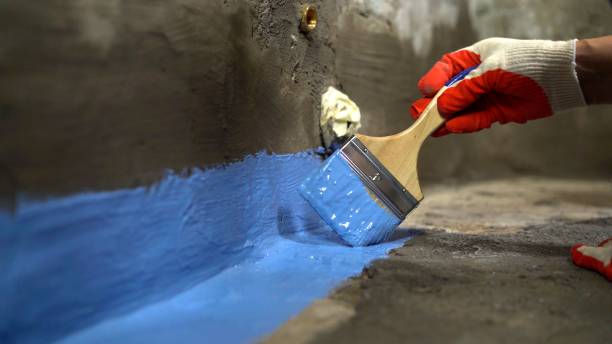
Bathroom floor waterproofing. Waterproofing the floor with a brush.Waterproofing concrete mortar. The master puts waterproofing on a concrete floor with a brush.
Pest control issues in your home can be a real nuisance requiring you to purchase traps, spray toxic chemicals, and hire professional pest control experts. After all that effort, pests will often return if the environment inside your home is well suited for their needs. The best form of pest control is to not give them the environment that lets them thrive or the entry points that give them access. That’s where basement waterproofing comes in.
By sealing up your home from water intrusion you are also sealing your home from any pests that may try to enter. By keeping your basement dry and free of mold you are taking away the environment that allows pests to flourish. In this article we’re going to dive into some steps you can take to waterproof your basement and also help with pest control.
What is Basement Waterproofing?
Basement waterproofing is a system of components that help prevent water intrusion in your basement and manage water on your property. Each component works together to increase the effectiveness of the system. Basement waterproofing can be split up into two sections, interior waterproofing, and exterior waterproofing.
Interior waterproofing includes:
- Sump pumps
- French drains
- Foundation wall wrap
- Crack repair
- Mortar resurfacing and repointing
- Applied waterproofing
- Dehumidifiers
Exterior waterproofing includes:
- Landscaping
- Window well installation
- Gutter installation and maintenance
- Exterior foundation sealing
- Dry well installation
How Basement Waterproofing Reduces Pest Infestation:
Pests like termites, cockroaches, silverfish, and rodents are drawn to damp environments. By reducing moisture, waterproofing makes the basement less hospitable to these unwanted guests. So, what are the steps you can take to decrease the moisture in your home?
Sealing Cracks and Crevices:
This will depend on the type of foundation you have. If you have a poured concrete foundation, then you may experience cracks in your basement walls. These will need to be repaired to prevent water intrusion and pest entry. They can be repaired from the inside through a crack injection process.
If you have a fieldstone or cinderblock foundation, then you will need to plug gaps between rocks and blocks with mortar with a process called repointing. You may also choose to add a skim coat of mortar for a more cohesive aesthetic and comprehensive coverage.
Managing Groundwater:
Managing groundwater requires a combination of exterior and interior waterproofing solutions. This is typically achieved through proper grading, installing gutters and downspouts, and sometimes adding exterior drainage systems like dry wells. For interior management of groundwater, you can install sump pumps and French drains.
Managing groundwater is not about stopping water, it’s about managing where it goes. By having systems in place that address the groundwater on your property you can effectively direct water away from your home. This will greatly reduce moisture levels in your basement, helping keep pests away.
Reducing Humidity Levels:
Humidity is heavy. When it enters your home, it settles into your basement causing a dingy, damp environment. High humidity gives mold, mildew, and pests an ideal condition to flourish. You can address the humidity in your basement by installing a dehumidifier. The humidity level in your basement should remain between 30 and 55 percent. Purchase a dehumidifier that allows you to set the machine to keep your basement within that level.
Health Implications of Basement Waterproofing and Pest Control:
The presence of water intrusion and pests in your home can have a host of negative effects on your health. Addressing these issues can make a difference to your health for a multitude of reasons.
Reduction of Mold and Mildew:
Mold and mildew can cause or exacerbate respiratory issues such as asthma, allergies, and other respiratory infections. By keeping your basement free of moisture issues, you are preventing the possibly of mold and mildew growth.
Prevention of Pest Related Disease:
Pests like rodents can carry a host of diseases which can be spread through direct contact or through their droppings. Indirect contact with rodents can also cause the spread of disease through ticks, mites, or fleas that are living on the animals. Other pests like cockroaches are known to trigger allergies and asthma.
Chemical Exposure Reduction:
Once pests have entered your home you may be forced to utilize toxic chemicals like pesticides to rid them from your home or prevent them from coming back. By properly sealing and waterproofing your basement you may be able to a take a more natural approach to preventing pest infestation and remove the need for chemicals altogether.
In Conclusion:
Making your basement waterproof is a great way to keep pests away. When your basement is dry, it’s not a place where bugs and rodents like to be. This means you won’t have to use as many chemicals or traps to get rid of them. Also, a dry basement helps stop mold and mildew, which can make you sick, especially if you have allergies or asthma. So, waterproofing your basement is not just about keeping it dry; it’s also about making your home healthier and more comfortable to live in.
Leave a Reply